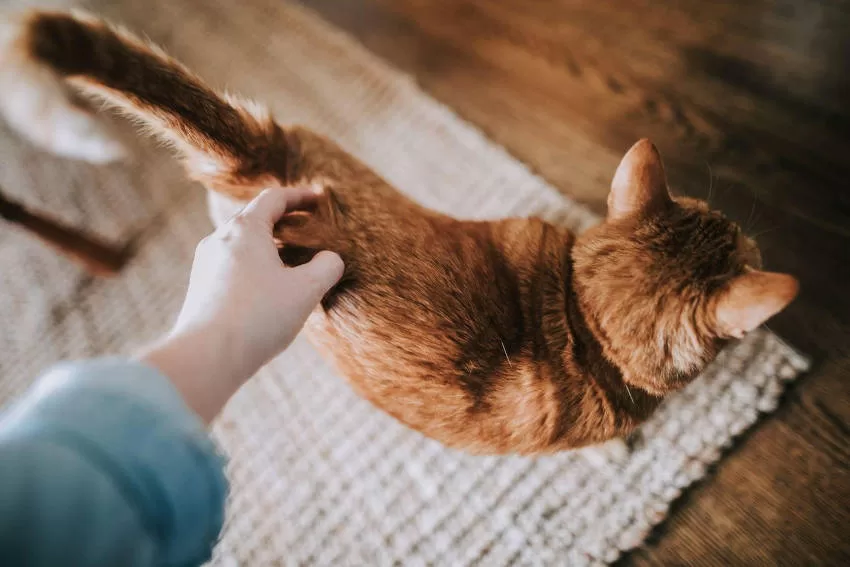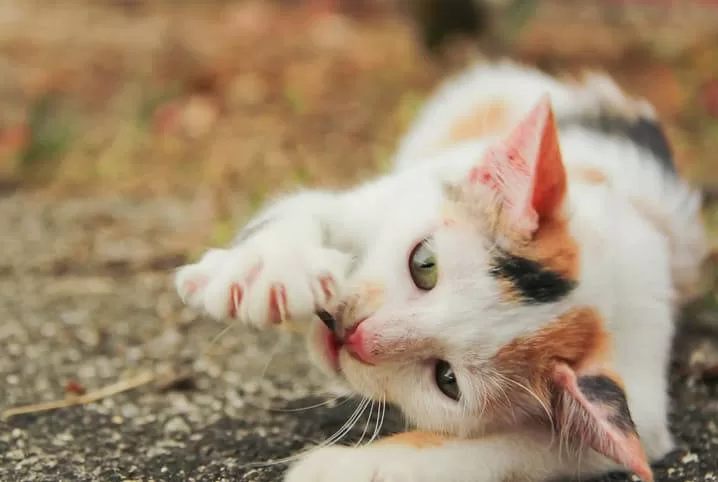Cats are fascinating and mysterious animals, but understanding their body language can help us decipher their behaviors and needs. Cat body language is a form of non-verbal communication that they use to express themselves and communicate with other cats and us, their humans.
Observing a cat’s body language can help us understand whether it is happy, scared, in pain or even feeling aggressive. By learning to interpret the subtle signals that cats send us, we can establish a better connection with them and create a more harmonious environment to live in.
Some common feline body language signs include:
- Tail erect and shaking: indicates excitement or happiness.
- Tail down or between the legs: sign of fear or submission.
- Ears back and flat: indicative of aggression or discomfort.
- Fixed gaze and dilated pupils: may be a sign of aggression or fear.
- Relaxed posture and stretched body: demonstrates confidence and tranquility.
In addition to these signs, it is also important to observe body language in conjunction with other aspects of the cat’s behavior, such as vocalizations, facial expressions and movements. Cat body language is complex and varied, so it’s important to pay attention to detail to fully understand what they are communicating.
By learning cat body language, we can establish a better connection with our felines and even train them more effectively. In the next article, we’ll explore the importance of basic cat training and how we can use body language to teach commands and reinforce desired behaviors.

The Importance of Basic Training for Cats
Basic training for cats is an essential part of ensuring their well-being and creating a harmonious relationship between them and their owners. While cats are known for their independent nature, they can still benefit from learning basic commands and understanding their owner’s expectations.
One of the primary reasons why basic training is important for cats is that it helps to establish boundaries and reinforce positive behaviors. By teaching your cat simple commands like “sit” or “stay,” you can effectively communicate what is expected of them in different situations. This can be particularly useful in preventing unwanted behaviors such as scratching furniture or jumping on counters.
Another benefit of basic training is that it provides mental stimulation for cats. Just like humans, cats need mental exercise to keep their minds sharp and engaged. Training sessions serve as a form of mental enrichment, keeping your cat entertained and preventing boredom-related issues like destructive behavior or excessive meowing.
Basic training also helps to strengthen the bond between cats and their owners. When you spend time teaching and interacting with your cat, it creates a positive association and builds trust. This can lead to a deeper connection and a more fulfilling relationship.
Additionally, basic training can be a crucial aspect of your cat’s safety. Teaching them to come when called or to stay in a designated area can prevent them from getting into dangerous situations or running away. Training your cat can also make visits to the veterinarian or groomer less stressful by familiarizing them with handling and restraint.
In conclusion, basic training for cats is not only about teaching tricks but also about establishing boundaries, providing mental stimulation, strengthening the bond, and ensuring their safety. By investing time and effort in training your cat, you can create a happier and more well-behaved feline companion.

Step 3: Teaching basic commands through body language
Once you’ve established a connection with your feline and understand cat body language cues, you’re ready to start teaching basic commands using that language. Cats are intelligent animals and can learn to respond to commands in a similar way to dogs.
Before starting training, it is important to keep in mind that cats have different personalities and not all of them will be willing to submit to commands. Respect your cat’s limits and be patient during the training process.
To get started, choose a simple command, like “sit” or “come.” Use a soft tone of voice and a relaxed facial expression when giving the command. Then, follow the command with a physical gesture that is easily understood by the cat, such as raising your hand when you say “sit.”
Reward your cat immediately when he executes the command correctly. This can be done with treats, praise or affection. Repetition is key to cat training, so practice the command regularly, but in short sessions to avoid cat boredom.
Additionally, it’s important to make training fun and stimulating for your cat. Use toys or games during training to keep him engaged. For example, you can use a toy that makes a sound when the cat executes the command correctly.
Remember that each cat is unique and may have different levels of learning ability. If your cat is having difficulty learning a specific command, try breaking it down into smaller steps and rewarding progress. If necessary, it may also be helpful to seek help from a professional cat trainer.
Finally, always reinforce your cat’s desired behaviors. Give him attention, affection and rewards when he demonstrates good behavior. This will encourage your feline to continue learning and respond to basic body language commands.
Read on to learn how to deal with unwanted behaviors and learn additional tips for basic cat training.

Step 4: Reinforcing desired behaviors
Once you’ve established a connection with your feline and understand their body language cues, it’s time to reinforce desired behaviors through basic training. Cats are intelligent animals and can learn simple commands as long as they are taught correctly.
To reinforce desired behaviors, you will need treats or rewards that your cat enjoys. Using food is a great way to motivate your feline to learn and practice basic commands.
First, choose a simple command, like “sit” or “give paw.” When your cat performs the desired behavior, immediately reward him with a treat and praise him in a soft, encouraging voice. Repeat this process several times throughout the day, always rewarding your cat when he performs the command correctly.
Remember to be consistent and patient during training. Some cats may learn more quickly than others, so don’t be discouraged if your feline takes longer to understand. Regular practice and positive reinforcement are essential for successful training.
Also, try to vary the rewards to keep your cat interested. In addition to snacks, you can use toys or affection as rewards. Find out what your feline likes most and use this as motivation during training.
It is important to remember that basic cat training should not involve physical punishment or cruel treatment. Use only positive methods, such as rewards and praise, to encourage your feline to learn.
If your cat has difficulty with a specific command, break it down into smaller steps and progress gradually. For example, if you are teaching your cat to jump in a certain place, start by rewarding him for approaching the place and then for touching it with his paws. As he progresses, increase the demands so that he jumps completely.
Remember to reinforce desired behaviors regularly, even after initial training. This will help keep your cat’s skills sharp and deepen your connection even further.

Step 5: Dealing with unwanted behavior
While basic cat training is important for teaching commands and desired behaviors, it is also essential to deal with unwanted behaviors. Here are some tips for approaching these situations:
- Identify the cause: Before correcting an unwanted behavior, it is important to understand the cause behind it. Some behaviors may be the result of boredom, lack of mental stimulation, or even health problems. Observing the context in which the behavior occurs and consulting a veterinarian if necessary can help identify the underlying cause.
- Ignoring unwanted behavior: In some cases, ignoring unwanted behavior can be effective. Cats often repeat behaviors to get attention, so by not paying attention to unwanted behavior, you are preventing it from being reinforced.
- Redirect the behavior: Rather than simply scolding the cat for the unwanted behavior, it is important to redirect the cat to an alternative, more appropriate behavior. For example, if your cat scratches the furniture, offer a suitable scratching post and reward him when he uses it.
- Use positive reinforcement: As with training desired behaviors, using positive reinforcement can be effective in dealing with unwanted behaviors. By rewarding your cat for behaving correctly and ignoring or redirecting unwanted behavior, you will be encouraging your cat to repeat the appropriate behavior.
- Avoid punishment: Punishing a cat for unwanted behavior can be counterproductive. In addition to not being effective, this can create fear and anxiety in the animal, which can lead to more behavior problems. It is important to remember that cats respond better to positive stimuli than to punishments.
Dealing with unwanted behaviors in cats can be challenging, but with patience, consistency, and the appropriate use of positive reinforcement, it is possible to modify these behaviors. Remember that each cat is unique and may require different approaches, so be willing to adapt your strategies as needed.

Step 5: Dealing with unwanted behavior
When it comes to training cats, it’s important to not only teach basic commands but also deal with unwanted behaviors. Here are some tips for dealing with these situations:
1. Identify the cause
Before correcting an unwanted behavior, it is essential to identify the cause behind it. Cats may exhibit unwanted behaviors due to boredom, stress, fear, or even health problems. Observe your cat’s environment and consult a veterinarian if necessary.
2. Use retargeting
An effective way to deal with unwanted behaviors is to redirect your cat’s attention to something more appropriate. For example, if your cat is scratching furniture, provide a suitable scratching post and praise him when he uses it. This way, you are redirecting your behavior towards something acceptable.
3. Set clear limits
It’s important to set clear limits for your cat. Use verbal and body language commands to show when behavior is unacceptable. For example, if your cat is jumping on the table, say “no” firmly and gently put him down. Repeat this process every time he repeats the behavior.
4. Ignoring unwanted behavior
In some cases, ignoring unwanted behavior can be effective. Cats may exhibit unwanted behaviors to get attention. If you react to these behaviors, even if it is to reprimand them, you are reinforcing the behavior. Instead, ignore the behavior and reward your cat when he exhibits a desired behavior.
5. Positively reinforce desired behaviors
Last but not least, remember to positively reinforce desired behaviors. Praise and reward your cat whenever he exhibits a behavior you want to encourage. This will encourage your cat to repeat this behavior in the future.
Dealing with unwanted behaviors can be challenging, but with patience and consistency, you can help your feline develop more appropriate behaviors. Remember that each cat is unique, so it may take time to find the right approach for your case. If necessary, consult a feline behavior professional for additional guidance.
Additional Tips for Basic Cat Training
When it comes to training your cat, it’s important to keep in mind some additional tips that can help make the process more effective and enjoyable for both you and your feline. Here are some suggestions to consider:
- Be patient: Remember that cats have individual personalities and training may take some time to get used to. Don’t get frustrated if your cat isn’t responding immediately to commands. Stay calm and continue to be consistent.
- Reward with affection and treats: Cats respond well to positive rewards, such as affection and treats. Whenever your cat correctly executes a command, reward him immediately to reinforce the desired behavior.
- Avoid physical punishment: Never use physical punishment to correct unwanted behavior. This will only scare and traumatize your cat, as well as damaging the trust between you. Opt for retargeting techniques or ignore unwanted behavior.
- Train in short, frequent sessions: Cats have a limited attention span, so it is best to conduct short, 5-10 minute training sessions several times a day. This will help keep the cat interested and make learning easier.
- Be consistent: Set clear rules and be consistent in your approach. Use the same commands and rewards in every training session so the cat can correctly associate words with desired behaviors.
- Have fun: Training doesn’t have to be a chore. Have fun with your cat during training sessions, use interactive toys and make the process fun for both of you. Remember that, above all, the goal is to strengthen the bond between you and your feline.
With these additional tips, you’ll be ready to train your cat using body language as an effective tool. Always remember to respect your cat’s pace and limitations, adapting training according to their individual needs. With patience, positivity and consistency, you will be able to decipher your feline and enjoy an even more harmonious and rewarding relationship.

Here are some additional tips to help you with basic cat training:
1. Be patient and consistent
Just like humans, cats also need time to learn and adapt to new behaviors. So be patient during the training process and avoid getting frustrated with your feline’s pace. Stay consistent in your approaches and rewards so your cat can correctly associate desired behaviors with rewards.
2. Use attractive rewards
Cats are motivated by rewards, so find something that is highly attractive to your feline. It could be a tasty treat or a favorite toy. Use these rewards during training to encourage your cat to perform desired behaviors.
3. Train in short, frequent sessions
Cats have a limited attention span, so training is best done in short, frequent sessions. About 5 to 10 minutes, two or three times a day is enough. This will allow your cat to concentrate better and avoid boredom.
4. Avoid physical punishment
Physical punishments, such as hitting or yelling at your cat, are not effective and can cause emotional and physical harm. Instead, focus on positively reinforcing desired behaviors and redirecting unwanted behaviors using reward-based training techniques.
5. Be creative
Each cat is unique and may respond differently to training. If one technique isn’t working, try alternative approaches. Be creative and try different methods to find what works best for your feline.
Conclusion
Training a cat requires patience, consistency, and understanding feline body language. With the additional tips provided above, you will be better prepared to train your cat effectively. Remember to adapt the training according to your feline’s personality and enjoy the process of developing a deeper connection with your cat through body language.
External Links:

